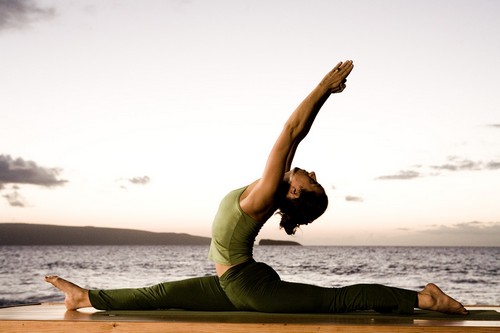What matters when stretching
As a silver bullet against muscle soreness, injuries and Co stretching exercises have long been used as desired both before and after athletic training. Scientific tests but have since found that it is crucial when and how that stretching exercises are performed.
 For most athletes stretching or stretching is just as much training as the training itself. Whether before or after sports, always stretching is used as a remedy for sore muscles, but also to reduce the risk of injury. Although this effect has since been disproved, stretching still has a place in the sport. However, stretching exercises should not be used as desired, but be tailored to the particular sport and used controlled. Thus, for example, improving the mobility through specific stretches and releases tension. Although the muscles by stretching no longer, as one might suspect, but the so-called sliding layers between the muscle fibers are optimized and even re-aligned the fibers so that the muscles are then smoother. At the same time tendons, ligaments and joints of stretching exercises benefit. For one thing, tendons and ligaments are strengthened through specific stretching and warming up. Secondly, water balance and metabolism in the joints are stimulated so that the articular cartilage is best equipped and better protected from injury.
For most athletes stretching or stretching is just as much training as the training itself. Whether before or after sports, always stretching is used as a remedy for sore muscles, but also to reduce the risk of injury. Although this effect has since been disproved, stretching still has a place in the sport. However, stretching exercises should not be used as desired, but be tailored to the particular sport and used controlled. Thus, for example, improving the mobility through specific stretches and releases tension. Although the muscles by stretching no longer, as one might suspect, but the so-called sliding layers between the muscle fibers are optimized and even re-aligned the fibers so that the muscles are then smoother. At the same time tendons, ligaments and joints of stretching exercises benefit. For one thing, tendons and ligaments are strengthened through specific stretching and warming up. Secondly, water balance and metabolism in the joints are stimulated so that the articular cartilage is best equipped and better protected from injury.
Stretch statically or dynamically.
General distinction must be made when stretched between static and dynamic stretching. In this case, under static stretching or stretching is understood a method in which the targeted muscles drawn in the length and are held in this position for 10 to 30 seconds. In dynamic stretching the muscles are contracted and relaxed, however, in rapid succession. After an appropriate warm-up program can thus activate the muscles involved and prepare for the following dynamic loads during practice or competition. Contrast, static stretching exercises improve the mobility of the individual muscle groups, especially if it is taken on an active static elongation at which a muscle is stretched, while the corresponding opponent is strengthened. Basically, stretching exercises, however, are only effective if they are not accompanied by pain, take into account the direction of action of each muscle and improve your general wellbeing.
Report this stretching can be counterproductive.
It is not always stretching exercises prove useful. So stretching can reduce muscle tone before exercise and thereby lead to performance degradation, especially when then fast and powerful movements are required. But after your workout stretching exercises can be counterproductive. Because just after an intense workout program by static stretching exercises circulation and muscle recovery and thus hinders muscle soreness and injury favored. Nevertheless, no one has to give up his stretching program, if he makes the right exercises at the right time.